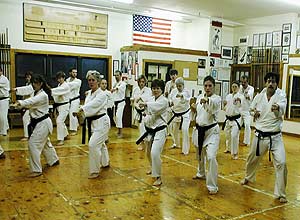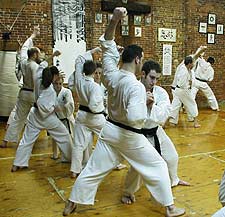What Is A Dojo?
By Jeff Brooks
Editor’s Note: This article is excerpted from Jeff Brooks new
book, “The Rhinoceros Tale” now being sold in our e-store.

When I opened my dojo, Northampton Karate, in the old Cutlery Mill in
Northampton Massachusetts, I had been training for ten years. I knew
that if I was to take responsibility for other people's karate practice,
to build on what was good in our tradition but not repeat the mistakes
of the past, I needed to answer precisely:
What is a "dojo"?
A room? No it can't be a room because the room our dojo is in once housed
rows of five ton drop-forges that pounded out sheets of metal into knives
and forks and spoons, for a hundred and fifty years before we got there.
And when we move out, as we will sooner or later, an office will probably
move right in. Several times a year we travel to practice at a beach
or a lake or in the woods or in a meadow or at another dojo and we say "the
dojo is going to the beach this weekend…" So the dojo can't
be the room.
Is the dojo the group of people? Not really, because since we opened
the dojo thousands of people have come and gone. And although some of
the current members have been practicing consistently for a long time
none of them were there the first day we opened, except me. None of them
have been there every day, and none will be there some years in the future,
including me, and yet it still is and will be the dojo.
 Does a dojo consist of a style of karate, a particular knowledge set?
Is it a certain way of moving or a group of techniques taught via a specific
teaching lineage? There are many places that teach the kind of techniques
we teach, but they are not all our dojo. And if you compared the way
we moved the day we opened to the way we move now, you would see that
the quality of the practice has changed and deepened. We teach some techniques
with a very different understanding than we once had. We teach ways of
moving that we didn't know then. We have added some valuable insights
and have discarded some methods that were not good. Does a dojo consist of a style of karate, a particular knowledge set?
Is it a certain way of moving or a group of techniques taught via a specific
teaching lineage? There are many places that teach the kind of techniques
we teach, but they are not all our dojo. And if you compared the way
we moved the day we opened to the way we move now, you would see that
the quality of the practice has changed and deepened. We teach some techniques
with a very different understanding than we once had. We teach ways of
moving that we didn't know then. We have added some valuable insights
and have discarded some methods that were not good.
The teaching lineage itself is not a particular thing. It is not a precisely
defined chain of people who passed on an unaltered system from generation
to generation. The lineage has had many influences. Many cultures crossed
paths on Okinawa. It was for centuries the confluence of many transmission
streams, flowing from different regions of China, from all over South
Asia and beyond, and filtered through many Okinawan teachers.
Selections - what the Okinawans and their teachers learned and what
they passed on - were made based on the aptitudes and understandings
and prejudices and compromises and discoveries of the practitioners.
Additions and deletions were made over time. Continually. Intentionally
and unintentionally. Styles are fluid. They are not stable, not fixed
at some point in history. We can document that martial arts styles are
not found artifacts, they are alive and responsive to conditions; they
are changing all the time. Although the name of our style has stuck for
the last fifty years, in the decades that I have been practicing I have
seen it change and seen many variations in the way our style is practiced
by different people in different dojos, in different countries. The dojo
is not the "style."
Is the dojo me? No. I am not there all the time. I teach only a fraction
of the classes on the schedule each week. The dojo would still exist
if I were gone tomorrow.
So what is it? We know it exists. We know it exists because we have
been practicing. Our bodies and minds and lives have changed. We have
experienced this. We know it. New people are seeking it out and joining
in and this is having a real effect on their lives. It exists. But what
is it, exactly?
Is this an important question? It is if you make the mistake of thinking
that the dojo is an institution with fixed qualities. That it is something
that can and will exist independent of or external to the lives and actions
of the people who practice in it.
We tend to take for granted the objective existence of the things that
sustain us. Then, sometimes, we presume upon them or take unfair advantage
of them. By cashing in the investment of spiritual capital earlier members
made in the group, we damage what was sustaining us. For example, crooks
who rig financial markets depend for the success of their crime on the
trust that their predecessors built, through their honest dealing. The
same kind of corruption can happen in a dojo when people wear ranks they
do not honor with hard work and good conduct, but instead trade on their
predecessors' reputations. This deception hurts their group in the future,
the other members, and ultimately will ruin their own chances of happiness.
It is similar to the way in which people sometimes take their families
or their marriages for granted. Or operate in the assumption that their
job is theirs for good. Or make the same false presumption as the old
European nobility who thought their social position, income, and relationships
were fixed, based on qualities inherent in them. Sometimes people take
their spiritual life as something bestowed and guaranteed; as if nothing
were required of them to make their inner life sound.
We act as if the world will retain its shape regardless of our action.
The decline that comes from this presumption can ruin good work, good
countries, families, companies, religions and dojos.
About the Author:
Jeffrey M. Brooks holds a Go Dan Fifth Degree Black Belt in Matsubayashi
Shorin Ryu, training in Okinawa, Japan and the USA, with Shoshin Nagamine,
the founder of the style, Takayoshi Nagamine, his successor, as well as
with numerous others in the Matsubayashi Ryu lineage and related Chinese
traditions. His Buddhist study and practice is with Rev. Issho Fujita,
resident director of Valley Zendo and Geshe Michael Roach of the Asian
Classics Institute. He has an M.F.A. from NYU Film School and works as
a speechwriter for public figures. He is founder and director of Northampton
Karate and Northampton Zendo in Northampton, Massachusetts, offering classes
daily for adults and children since 1988. (www.northamptonkarate.com)
|